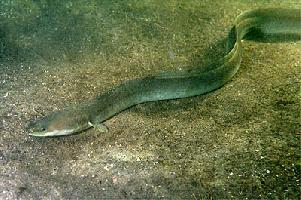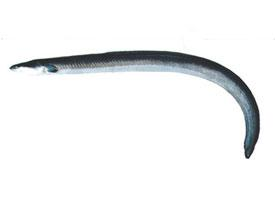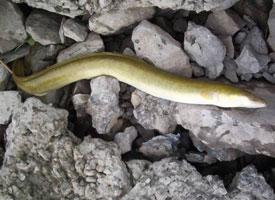
Stav ohrožení
| Ohrožen |
Popis zvířete
The European eel (Anguilla anguilla) is a fascinating and mysterious species of fish that has intrigued scientists and fishermen alike for centuries. This species belongs to the family Anguillidae and is known for its remarkable life cycle and long migrations. The European eel is native to the rivers and coasts of Europe, ranging from the northern reaches of Scandinavia to the Mediterranean and North African waters.Adult European eels have a serpentine and elongated body, which can stretch up to a meter in length, though sizes around 60 to 80 centimeters are more common. They possess small, yet sharp, pectoral fins near their head, and their dorsal, caudal, and anal fins merge into one long, continuous fin that runs along most of their body, aiding in their sinuous swimming style. The skin of the European eel is smooth and covered in a layer of mucus, which not only facilitates their movement through water but also makes them difficult to grasp. Their coloration varies with age and environment; adults are generally dark green or brown on their backs, transitioning to a yellowish or silver belly, which gives them excellent camouflage in their aquatic habitats.
European eels are catadromous fish, meaning they spend most of their lives in freshwater or brackish environments but migrate to the ocean to spawn. This journey is one of the most extraordinary aspects of their biology. Eels born in the Sargasso Sea, a region of the North Atlantic Ocean, will travel thousands of kilometers to reach their European habitats. This migration occurs in the larval stage, known as leptocephali, which are transparent and leaf-shaped, making them difficult to detect in the open ocean waters.
Once they reach the continental shelf, they transform into glass eels, and upon entering freshwater or brackish waters, they become elvers, which are characterized by their dark pigmentation. As they grow and mature in European rivers and lakes, they are known as yellow eels. This phase can last for a significant portion of their lives, anywhere from 6 to 20 years, during which they will grow and prepare for their final journey back to the Sargasso Sea to spawn and then die, completing their life cycle.
The diet of the European eel is varied and opportunistic. In their juvenile stages, they feed on small invertebrates, such as insects, worms, and crustaceans. As they grow larger, their diet expands to include fish and, in some cases, small mammals or birds, showcasing their adaptability and prowess as predators.
European eel populations have seen a significant decline in recent decades, due to a combination of factors including overfishing, habitat loss, barriers to migration such as dams and weirs, pollution, and diseases. This has led to the species being listed as critically endangered by the International Union for Conservation of Nature (IUCN). Efforts are underway across Europe to protect this enigmatic species, including habitat restoration, eel ladder installations to aid their migration, and restrictions on fishing.
The European eel's life cycle, with its long migrations and dramatic transformations, not only makes it a subject of scientific fascination but also highlights the complex interdependencies within ecosystems and the impact human activities can have on the natural world. As conservation efforts continue, it is hoped that the mysteries of the European eel's biology can be fully understood and that this remarkable species can be preserved for future generations.
Podobná zvířata
Nové fotografie zvířat
Top 10 zvířat
- Elephant hawk moth (Deilephila elpenor)
- Common house mosquito (Culex pipiens)
- Fruit fly (Drosophila melanogaster)
- Wasp spider (Argiope bruennichi)
- Australian box jelly (Chironex fleckeri)
- Common cockchafer (Melolontha melolontha)
- Colossal squid (Mesonychoteuthis hamiltoni)
- Bee hummingbird (Mellisuga helenae)
- Moustached guenon (Cercopithecus cephus)
- Diana monkey (Cercopithecus diana)

